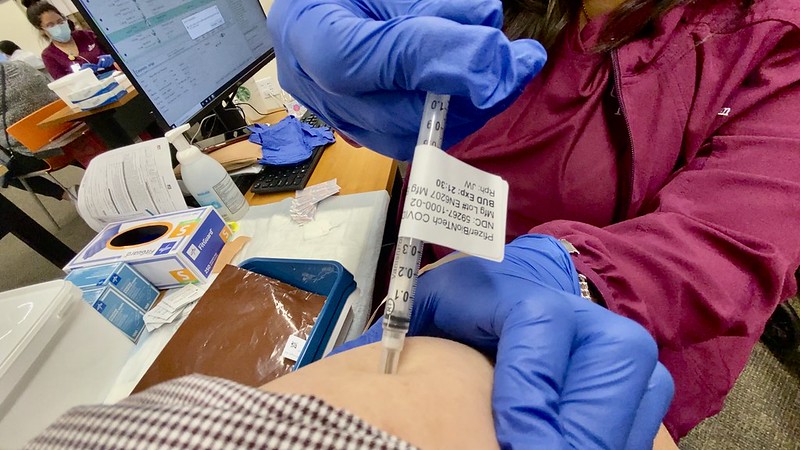Protecting Human and Animal Health by Mitigating the Spread of Viruses
ARS research informs and provides solutions to improve the U.S. biodefense posture, a crosscutting issue for both agriculture and public health. The risk of disease introduction—whether natural, intentional, or accidental—is increasing due to climate change and the increased movement of animals, plants, arthropods, and people around the globe. These diseases are a threat to food security and to human, animal, and environmental health. The following accomplishments in 2021 highlight multidisciplinary efforts across ARS to prevent, mitigate, and respond to the spread of viruses.
Novel spatial insect repellent dispensing devices to protect military troops. ARS scientists in Gainesville, Florida, treated bootlaces with various formulations of spatial insect repellents and tested them under laboratory and semi-field conditions. The treated bootlaces provided effective repellency more than 3 meters (approximately 9 feet) in all directions against the yellow fever mosquito (Aedes aegypti) for more than 3 months. Additionally, novel tent entrance devices were designed and evaluated under semi-field conditions and provided significant spatial repellency against four mosquito species, including three genera that carry disease. The yellow fever mosquito spreads numerous human diseases (dengue fever, chikungunya, Zika fever, Mayaro, and yellow fever) and these repelling devices will help protect combat forces deployed to environments where these mosquitos thrive; they could also protect civilians, if they are marketed for the public.
Discovery of 33 toxin-producing, plant pathogenic fungi. During the past three decades, epidemics of the fungal disease Fusarium head blight (FHB) have caused economically devastating damage to wheat and barley in the United States and elsewhere around the world. FHB significantly reduces seed quality and yields and contaminates grain with toxins that pose a serious global threat to agricultural biosecurity, food safety, and human health. ARS researchers in Peoria, Illinois, characterized the genetic diversity of a global collection of 171 Fusarium strains either known or predicted to produce toxins. The 171 strains comprised 74 different species, including 33 that are new to science, and the species were distributed among 6 species groups that corresponded to the type of toxins they produce. The researchers found that species within only two of the six groups could cause FHB of wheat and contaminate grain with toxins. These data further suggest that the type of toxin produced contributes to the ability of these plant pathogens to cause disease. These findings will be of interest to plant disease specialists and quarantine officials who are focused on minimizing the threat these toxigenic molds pose to U.S. and world agriculture. Moreover, knowledge gained from this research should assist plant breeders in developing cultivars with broadbased resistance to FHB.
Managing tomato brown rugose fruit virus. Tomato brown rugose fruit virus (ToBRFV), an emerging and economically important plant virus, has caused serious disease outbreaks on greenhouse tomatoes around the world in recent years. This seed-borne and mechanically transmitted virus poses a serious threat to the $2.5 billion tomato and pepper industries in the United States. Recently, ARS researchers in Charleston, South Carolina, reported an outbreak of ToBRFV on tomato for the first time in the United States. Based on this report, USDA-APHIS issued a federal order to inspect all imported tomatoes and peppers for ToBRFV infection to prevent potential devastation to the U.S. tomato industry. In addition,
the researchers conducted molecular and biological characterizations of ToBRFV isolates in the United States and developed a highly sensitive real-time PCR detection system for the virus that can also be used for seed health testing. Additionally, several disinfectants that kill the virus and prevent the disease from spreading have been identified and recommended to growers. Furthermore, the researchers screened available tomato germplasm and identified new sources of resistance that are being used in breeding to develop plants with resistance to the virus. These research findings will provide fundamental knowledge and practical solutions to prevent and protect tomato and pepper crops in the United States and around the world from potential devastation by this emerging and economically important plant pathogen.
A new method to screen the gastrointestinal microbiome of livestock. The microbiome is the combined genetic material of all microorganisms—such as bacteria, fungi, protozoa, and viruses—that live in a particular environment. ARS scientists in Madison, Wisconsin, and Beltsville, Maryland, led research conducted by an interdisciplinary team of international researchers from four countries and two private United States companies to develop new methods for microbiome screening to identify the organisms present. Using the latest high accuracy, long-read DNA sequencing technologies, microbial strains could be resolved down to single nucleotide variants. More than 44 bacterial genomes were assembled into single, continuous chromosome genomes, which is the greatest number ever achieved in a single sequenced sample; more than 400 viral- and 250 plasmid-host associations were identified. These discoveries represent the highest resolution image of genomic DNA in a gastrointestinal sample, furthering the interpretation of microbiome sequencing discoveries and the future identification of ‘high-value’ organisms influencing animal efficiency and health.
 Cheung, Lance. 2019 novel coronavirus disease — COVID-19 —vaccination injection into an arm on March 18, 2020, in San Antonio, TX. USDA Photo. https://flic.kr/p/2kNxNcT
Cheung, Lance. 2019 novel coronavirus disease — COVID-19 —vaccination injection into an arm on March 18, 2020, in San Antonio, TX. USDA Photo. https://flic.kr/p/2kNxNcT

